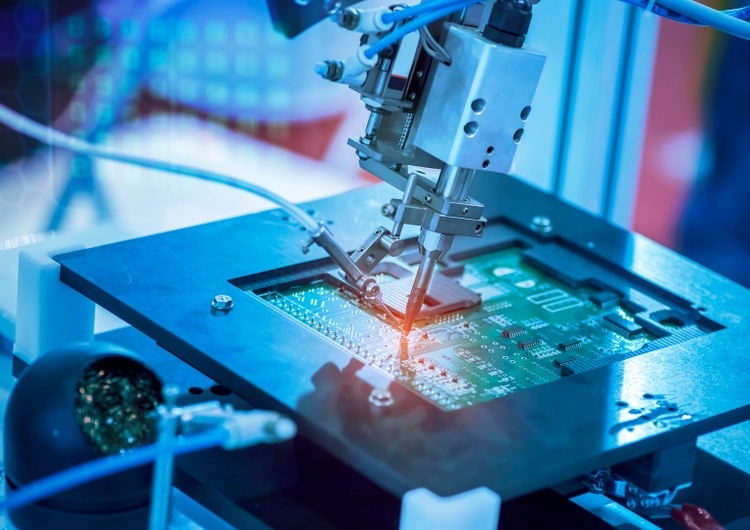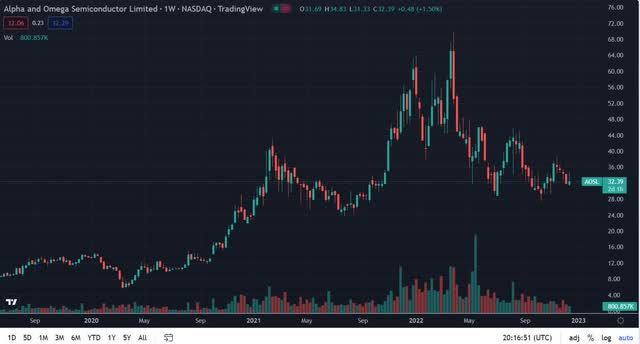kynny/iStock via Getty Images
Alpha and Omega Semiconductor Limited (NASDAQ:AOSL) has enjoyed a nice run since it started to take off in late March 2022, when it was trading at approximately $6.00 per share.
Almost exactly two years later, on March 28, 2022, it climbed to its 52-week high of $69.99, before collapsing by over 50 percent to its 52-week low of $27.38. Since then, it has modestly recovered to trade at a little over $32 per share as I write.
This isn’t surprising, since the high-growth tech sector has been under pressure since the Federal Reserve and other central banks decided they were going to tackle high inflation by raising interest rates; something that they’re still in the process of doing.
In this article we’ll look at some of the latest earnings numbers of AOSL, how its segments have been performing, and what the future looks like for the company.
Some of the latest earnings numbers
Revenue in the first fiscal quarter of 2023 was $208 million, up almost $20 million, or 11.5 percent, from the $187 million in revenue generated in the first fiscal quarter of 2022.
Gross margin in the reporting period was 34.1 percent, slightly down from a gross margin of 34.5 percent year-over-year.
Net income in the quarter was $26 million, or $0.88 per share, compared to net income of $23.4 million or $0.85 percent in the same quarter of fiscal 2022.
Consolidated cash flow in the first fiscal quarter of 2023 was $36.7 million, compared to $25.7 million sequentially.
Cash and cash equivalents at the end of the quarter were $316.1 million, with long-term debt of $47 million.
Guidance for the second fiscal quarter of 2023 ending in December 2022, is for revenue to drop to about $195 million, with gross margin projected to be approximately 30 percent.
While seasonality was one of the reasons attributed to its expected weaker performance, factors like a change in product mix and inventory corrections which will lower factory production are headwinds, in some of its segments, that are likely to continue for the next couple of quarters.
In regard to the product mix and inventory correction, that’s primarily a reference to PCs and smartphones. Consequently, not only will that result in lower shipments of high-margin products in the quarter, but also a higher number of low-margin products being shipped, which will put downward pressure on the top and bottom lines of the company.
The company drew these conclusions from its customers changing orders in the backlog, which is causing AOSL to adjust its production schedule; by far the most impact is on its PC segment.
Breaking down the segments
Computing segment
Even though revenue in computing climbed 13.6 percent year-over-year, it was flat in comparison to the prior quarter, and that slowdown in sales is projected to continue in the second fiscal quarter, with the company expecting sales to fall 20 percent sequentially. Again, that is based upon changes its customers made in the backlog.
With revenue in Computing accounting for 42.8 percent of overall revenue in the quarter, it’s easy to see this is going to have a significant impact on the performance of the company.
Among the stronger categories in the segment were data centers, tablets, notebooks, and graphic cards.
The inventory correction in the Computer segment suggests slowing demand, which will probably continue on into calendar 2023. PC demand is expected to remain soft, while tablets and data centers should continue to be strong going forward.
That won’t fully offset the drop in PC demand, but it’ll help it some.
Consumer segment
The Consumer segment of AOSL has been gaining momentum, with revenue jumping 11 percent year-over-year, and 23 percent sequentially. It now accounts for 27.7 percent of total revenue for the firm. This was led by increasing demand in gaming.
As far as volumes go, gaming soared by a record 122.7 percent year-over-year and 70.2 percent sequentially.
The company believes gaming will continue to enjoy double-digit growth from its record gaming shipments, especially in relationship to the leading share it has from the #1 gaming console manufacturer.
Communications segment
Its Communications segment climbed 21.8 percent year-over-year and 5.1 percent from the prior quarter. This segment represents 15.1 percent of overall company revenue.
Communications was strong in the reporting period because September is usually the peak season for shipment of smartphones; that’s particularly true of the U.S. market, which is the company’s top market in the smartphone category.
The reason for the seasonal strength is because its leading smartphone customer usually refreshes its devices in the U.S. market in preparation for the holiday season.
Other smartphone markets that have been strong are China and Korea, primarily from the company’s strength in the high-performance battery protection category, which targets the high-end of the market. Based upon the inventory correction in the smartphone industry, the quarter ending in December is going to drop by an estimated high-single digits, with China being the major headwind there. The U.S. smartphone market should continue to be strong, while Korea is expected to be flat in the quarter.
Power Supply and Industrial segment
The Power Supply and Industrial segment jumped by 8 percent year-over-year, and 14.3 percent from the previous quarter.
The two main positive catalysts there were the increase in sales of quick chargers from the top U.S. phone maker, along with growth in the power tools category.
The company projects growth in the high-single digits in the segment, primarily from ongoing growth momentum of quick chargers as the company increases the number of designs it has across multiple devices in the category for the top phone maker in the U.S.
Conclusion
AOSL’s recent performance has been mixed, and because its Computer segment slowing down while accounting for about 43 percent of overall sales, it’s going to weigh on the company’s future performance until demand for computers grows again.
With computer and smartphone demand falling, overall, in the markets it competes in, the company has lost some of its positive catalysts on a temporary basis, which will probably last for at least the next couple of quarters.
Since companies are starting to take longer looks at spending projects, its computer business could have demand decrease until the Federal Reserve and other central banks stop raising interest rates, as that has a disproportionate effect on high-growth tech companies like AOSL. As for a good entry point, the share price of AOSL dropped to a 52-week low of $27.38 in mid-October, and even though it has recovered some since then, I think there is probably more downward pressure to come in the next couple of quarters, which is likely to test the former low.
For that reason, I think it would be prudent to wait to see if there is more downside in the share price before taking a position. While the current share price of about $32.00 isn’t a bad entry point, if the company continues to underperform over the next two quarters, I think there will be a much better price available for investors.



Be the first to comment